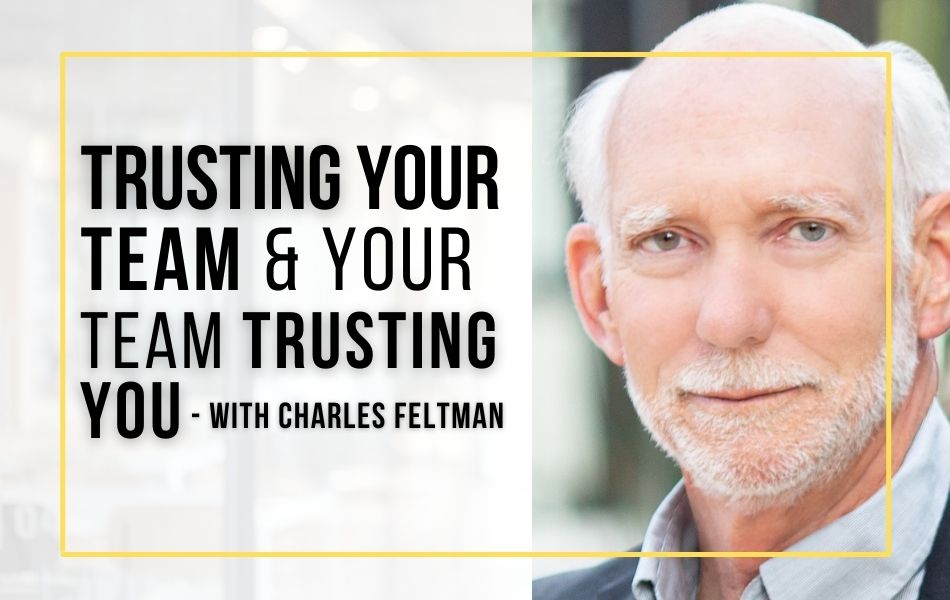
204. Letting Someone Go
About this Podcast
Ep. 204 – Imagine that sinking feeling when you realize you may have to let someone go from your team.
It’s one of the most difficult situations a manager faces. In most cases, the manager has been feeling this tugging going on for a while but has put it off, hoping that things would improve. But at some point they have to face the inevitable. What’s worse, if they were the one that hired this employee, they may also be struggling with guilt, feeling at-fault for how the situation turned out.
In this episode, Ramona provides guidance on how to approach the process of letting someone go with clarity and compassion. She brings up key questions to ask yourself to assess if termination is warranted and introduces you to the AMO framework to help identify gaps that may be hindering the employee’s performance.
Even if termination is the ultimate outcome, there are ways that it can be done with clarity and compassion for everyone involved, including the remaining team members.
If you’ve been grappling with an underperforming employee or want to prepare for when (not if!) this situation will arise for you, then you must tune in to this episode.
Watch it on YouTube here.
Episode 204 Transcript:
0:00:00 Ramona Shaw: This is episode two four. On the difficult topic of letting someone go, here’s the question.
0:00:06 Ramona Shaw: How do you successfully transition into your first official leadership role, build the confidence and competence to lead your team successfully and establish yourself as a respected and trusted leader across the organization? That’s the question, and this show provides the answers. Welcome to The Mentor Track podcast. I’m your host, Ramona Shaw, and I’m on a mission to create workplaces where work is not seen as a source of stress and dread, but as a source of contribution, connection, and fulfillment. And this transition starts with developing a new generation of leaders who know how to lead so everyone wins and grows.
0:00:41 Ramona Shaw: In the show, you’ll learn how to think, communicate, and act as the confident and competent leader you know you can be.
0:00:49 Ramona Shaw: Welcome to the Manager track podcast. Today, I want to talk about the topic of having to let someone go. This is coming from several conversations that I had in different groups of our leadership programs at Arcova, where in the groups we’ve talked about, why is it so hard to let people go? And why is it that oftentimes we delay that decision too long and only after the fact? Recognize that we should have probably pulled the plug a while ago, but the things get in the way of us doing so. And I’ll talk about why it is difficult to let someone go, but also share some frameworks with you or questions to think through to help you understand when is it that I am ready to make that decision?
0:01:36 Ramona Shaw: What are some considerations to think through before making such a decision? And then, as I said, we’re going to talk about what holds us back from making that decision. But once a decision is made and we have to let someone go, I’ll also share a few key principles to keep in mind for that process. Let me start first with a quick example. This is a scenario that’s very, very common. And I want to say probably it’s a rough guess, but probably half of our clients have shared that they’ve been in this kind of situation either recently or a while back. But this definitely is a situation that resonates with about half of the leaders that we support.
0:02:20 Ramona Shaw: Okay, so here’s the scenario. A new manager has taken over a couple of people, maybe former peers, to form the team, but then also hired two new additional people. And so as a team of five, they’ve been sort of tugging along, and that new manager wants to prove that they’re good leaders, that the team likes them and respects them, and that they’re all doing well. They know, like all new managers that all eyes are on them. The team is watching.
0:02:47 Ramona Shaw: That’s their first leadership role. They know that. Most of them will know that. But also, senior leaders want to make sure that you’re successful. They’re keeping an eye on it, on how you’re doing, and you’re fully aware. So imagine you’re being in this scenario, and you realize that one of those people that you’ve hired, in addition to the two people that you’ve taken on, is not doing so well. They’re not keeping up with the deadlines. The work product isn’t what you’re hoping for or what you’re expecting of them, and you keep telling them, hey, we got to do more, or, I’m expecting something different, or, why was the deadline not met?
0:03:24 Ramona Shaw: But really, the things start to add up, and you start to question, was this a good choice? Is this reversible, or am I having a people problem here that I need to solve? In this situation, not only is it that you’d likely be distracted by the situation, a big mistake would also be in that moment to focus most of your development efforts on that one person who isn’t performing, and the other three people in the team get very little of your attention when it comes to their professional growth or their development, or even just day to day support, because you’re so focused on the thing that isn’t working, which, by the way, our brains tend to do that. Right? We have this negativity bias. We pay most attention naturally, we’re inclined to pay most attention to the things that aren’t going well.
0:04:15 Ramona Shaw: But as leaders, we have to recognize that and shift right to recognize, hold on. I know that’s where I want to go, but I know better. I know that that can only be, let’s say, 20% of my attention. The remaining 80% should be on those who perform well or even excellent performers. That’s what good leaders do. You knowing that, you just have to take yourself out of it and say, hold on, I’m overspending my time here on this person who’s struggling versus supporting everyone else.
0:04:42 Ramona Shaw: If you’re not doing that, or if you’re not addressing the problem with this underperformer, your team will also start to get resentful and start to feel the impact. They likely have to pick up slack. They know that, a, you’re distracted, or b, that they’re carrying someone else’s load. They start to feel like, hey, hold on a second. Why is this being tolerated? If that person still gets a paycheck, what am I doing here? Trying to exceed expectations or giving my best or working overtime or just working really hard to do my work.
0:05:15 Ramona Shaw: And that can impact, negatively impact the morale of the team. So you’re now in this situation where, okay, you notice it’s draining your energy. You start to not like that part of your job. That person is struggling, the underperformer is struggling, and the rest of the team is also not happy, and it starts to get bigger and bigger. This is likely when we start to know we’ve probably been in this for too long without taking enough actions early on.
0:05:44 Ramona Shaw: So that’s the situation we want to prevent. So let’s talk about how to do this. A few questions to ask yourself the moment that you’re recognizing someone’s not quite meeting expectations is one. Knowing what you know today, would you hire them again? That’s one question to ask. The answer to that question will likely give you some clarity or insights. If you wouldn’t hire them, ask why? What is it that you assumed versus what you know now?
0:06:14 Ramona Shaw: If you would hire them again, it’s so great. Maybe all the issues are not that bad. Two, have you clearly communicated the gap between what they’re delivering and what the expectations are? And are you sure, 100% sure, that they understand that gap? I’ve once been in a situation where I’ve thought I’ve communicated the performance issue numerous times. Only then to hear that after the annual performance review, that person thought that they’ve heard it for the first time.
0:06:49 Ramona Shaw: And I was baffled. And I said, but I said it. And I remember saying to my boss at the time, that’s not possible. I said this, three, four, I want to say five times previously, this is not the first time they heard it. And my manager said, well, you said it, but are you sure that they heard you? That is two different things. So you want to be 100% sure that they understand what you’re saying. They recognize the gap. They say it back to you or recap it.
0:07:22 Ramona Shaw: They know what they need to do. Yes, I understand. Or here’s the summary of our feedback conversation today. Asked for this in an email, I heard you say, I need you to get better at XYZ, and here’s how I try to go about it. That is one way that you will know that they heard it. Okay, so that’s number two. Question number two, have you clearly communicated and do they know? Number three, do you believe they have the potential to meet the expectations?
0:07:53 Ramona Shaw: And if they’ve done so in the past, and this is just a time in their life. Or maybe they have personal challenges where it’s hard for them to keep up, but they’ve done it in the past. Or have you never seen them deliver on these kind of expectations and you’re starting to think they may not be ready yet, or you don’t have enough time or resources to get them there, or it’s just not within their strength profile.
0:08:17 Ramona Shaw: What is it? So those are three questions to ask yourself. Another framework that might help if you have someone that you consider letting go is the Amo framework, and that stands for a for ability, M for motivation, and o for opportunity. So you’re going to ask yourself, do they have the ability to perform the job to the expectations? Is it a skill match? Oftentimes the skill profile, the strength profile of that person, may just not be matching what that role requires.
0:08:54 Ramona Shaw: It’s not that they’re a bad employee. It is that their profile of strength or the culture or the environment is not fitting what this role provides. And when it’s not a fit, it’s not going to work. It’ll be an uphill battle for both sides and usually just ends in exhaustion being drained or their career progression stagnating because they’re never going to get to that next level where if they were in a job where it was a match, their path would be a lot easier, and your path to building a high performing team would be a lot easier.
0:09:30 Ramona Shaw: Okay, so is it an issue of ability? Are the skills or the strengths not matching? And then if yes, can you provide skill training to bridge the gap or not? So that’s one. The second is motivation. Do they receive performance feedback? Do they have incentives to do better to increase their performance? Are their rewards aligned with what you’re looking for? Do they have opportunities for career progression?
0:10:04 Ramona Shaw: Not to say that they personally do, but in the company, do they think, oh, no, if I do a good job, I can see how that will help me in the future as much as it is helping me now. And do they have a sense of job security? Those factors like the feedback, the recognition, the incentives, rewards, pay bonus, all of that and job security play into how motivated someone may be or may feel to meet your expectations if they’re not there yet.
0:10:35 Ramona Shaw: So assess if there’s complete alignment with that or if there’s anything that could get in the way of them feeling motivated to up level their performance. The third in the AMO framework is opportunity. Do they have the opportunity really to up level? Do they get all the information that they need? Do they have access to the resources that they need? Do they receive guidance and directions when needed?
0:11:02 Ramona Shaw: Do they feel that sense of support? Or can they collaborate with the right people to help them? Do they have flexibility in their own way of working? Because maybe the way that you want them to do something isn’t how they like to go about it. So are you providing them with enough flexibility so that they can deliver on the end result, even if the path to getting there is different, that goes hand in hand with ownership. Do they feel like they really own the tasks and the solutions and the problem?
0:11:34 Ramona Shaw: Or are you stepping in or micromanaging or getting too involved where maybe that sense of ownership is no longer there and they feel they’re just your assistant now and they don’t own anything here? Are you giving them the opportunity to own it? Are you giving them the flexibility to come to that end result, even if it’s a different way? Are you providing them with that sense of involvement or the connections, information, all of that?
0:12:02 Ramona Shaw: So these are three factors to consider as you’re doing an assessment of what might be getting in their way and what levers do you have to help them increase their performance? As a caring and driven manager, I know you want to strengthen your leadership skills, advance your career, and lead a high performing, engaged team. And in order to do that, as a leader, you need to lead with a system, not by shooting from your hips or reacting to everyone else around you.
0:12:29 Ramona Shaw: To do so, you need to first learn what should go into your leadership system, and second, develop your own. But here’s the good news. I created a concise, actionable, and yet comprehensive course on one component of the leadership system, and this is about how to successfully run one on one meetings with your direct reports. It includes over 67 minutes of tactical leadership training, plus a set of resources to make this as easy and immediately applicable for you as possible.
0:12:59 Ramona Shaw: You can get your hands on this course, which I want every single manager to have for a nominal $19 at ramonashaw.com eleven. That’s two times the number one. You can check the show notes for the details or head on over to ramonaja.com eleven and get started right away. What many companies use is a performance improvement plan, and that is for a lot of employees that sort of like, yeah, I know I’m going to get fired when they’re on a performance improvement plan, and it’s just a way to tell someone, we kind of want to let you go, but we can’t just let you go without doing a pay. So we’re going to give you a pip, but really the chances of you staying are low, and I would challenge that a little bit. I’ve seen so many turnaround cases, so to speak, where someone was put on a pip, but the pip was the first time that they really got clarity on what specific areas am I underperforming in?
0:13:55 Ramona Shaw: What kind of goals do I need to achieve? What kind of resources do I get in order to or have in order to achieve that? What’s the timeline for improvement? And they feel that sense of pressure, their back maybe against the wall, where they realize, like, hold on a second, I don’t want to lose this job. I’m going to give everything I can, and I have a clear plan on how to do this, and people will rise to the occasion.
0:14:20 Ramona Shaw: So give it a chance. A pip is a pretty strong message that you send, but there is hope some people will turn it around. And if you’re sending a pip, be aware that if you’re sending it just for formality and you already know you’re going to let them go. That may be one thing, but also consider it as an actual opportunity. It could be a tool that turns around a situation for your employee. Why is this so hard, though?
0:14:46 Ramona Shaw: It’s not that complicated. We have expectations, job descriptions. We set goals. We set clear behavioral norms, such as be on time or do this in a certain way. We’re communicating. Hopefully we’re communicating all that very clearly. And then if someone doesn’t do it, it’s like saying, yeah, it’s like not what I asked for. Right. But we’re making this a really hard thing for a number of reasons. One is we’re definitely emotionally attached, often to either the person, personal connections, there may be really nice people.
0:15:24 Ramona Shaw: They get along with people. They’re really trying, or we may also have an emotional attachment to their success because we are the ones who hired them. So we want to make sure that this hire is going to turn out well because it was my decision to hire them. So if I have to let them go now, three, six months, a year later, I have to acknowledge I made a hiring error. So these fears and concerns are real.
0:15:52 Ramona Shaw: What you want to keep in mind is what senior leaders will judge newer managers on is not, are they great hiring managers? Are all the people that they hire, are they going to turn out as high performers? No. We all know hiring decisions are made on incomplete information. There’s always a risk, even for the best of the best, that the person that they hire isn’t going to work out. So that’s not their biggest concern. Their biggest concern is that you recognize there’s a problem and you’re not acting on it fast enough either.
0:16:25 Ramona Shaw: With interventions, performance, coaching. Right. An assessment of the root cause, having the difficult conversations, addressing the elephant in the room, no sugar coating, being very clear, being kind and supportive, managing that situation well. And when you recognize there’s no end in sight, or this isn’t going anywhere for either of you, then making the hard decision. Senior leaders will want to see that you do all that way more than they want to know. If you’re hiring great. And not all of them are high performance.
0:16:58 Ramona Shaw: That’s not possible, even for the best. Another fear that gets, in a way is fear of just confrontation. Knowing that I’m going to have to let someone go, or I’m going to have to tell someone that they may be let go or that something isn’t working is usually not a good feeling. So the fear of confrontation is real, and that may prevent you from doing what you know intellectually that you need to do.
0:17:19 Ramona Shaw: Another thing could be concerns about the team. Right. If they’re well connected with team members, you may start to worry that the moment they leave that conversation that they’re going to go share that with their colleagues, and that overall, the whole team will suddenly turn on you. Plausible. The chances are way higher, though, that other people are already seeing the underperformance, and they may just be waiting for you to say something. And the longer that you hold out and not saying it, the less good it looks for you. So you’re actually addressing it is usually a sign that you’re a good leader, especially if you’re doing it in a kind, supportive way.
0:17:56 Ramona Shaw: Another thing that gets in the way is self doubt, or even guilt. Like guilt for not having done certain things in the past. And then you take it on you and you think, oh, it’s my mistake or doubt, oh, maybe it’s just me, maybe I’m asking too much, maybe my standards are too high, maybe I’m not supporting them enough. And because you’re sort of ruminating in the guilt or the self doubt, you also don’t know how to go about it.
0:18:22 Ramona Shaw: Possibly you don’t have any training or not a whole lot of support. You may just procrastinate on it and hope things will just turn out without you having to make those tough calls. Very valid. We can all see. Yeah, I can see how that happens, but again, makes it worse than it helps. If you’re doubting yourself and you’re unsure, speak with someone speak to a coach, to a mentor, to HR, to your boss, speak to someone, talk about the situation, talk about what you’ve already done, and talk about what options you have on the table and present that to them to then say, am I missing anything? Is there something that I may not look at? Right, or other options that you see that we have?
0:19:09 Ramona Shaw: How would you go about it? Get that kind of support, especially if you’re somewhat new and this may eat the first person that you’re letting go, or you’ve only done it a few times. This can be really hard. It’s one of the most uncomfortable things to do as a manager. So you are doubting yourself is normal oftentimes. Also, it means that you have the human connection. It means that you have empathy and compassion. You realize this is hard in the moment, even if it’s better for both parties in the long term, it makes you human.
0:19:43 Ramona Shaw: So not a big deal. So not a problem at all. Just notice, oh, this is what’s going on. And I can’t let my emotions, my doubts, my guilt, my fears, my emotional attachments rule my way of leading. That is not going to be useful. So acknowledge it. But decide based on the information you have at hand and based on the frameworks or questions that I shared earlier. When you now get into the situation where you do actually have to let someone go, three things to consider.
0:20:16 Ramona Shaw: One, do it with clarity and compassion. The most compassionate thing and the most clear thing you can do is to go straight into it. If you call that meeting, there’s no chitchatting about how was your weekend? And so and so, but no, this is going to be a really difficult conversation to have. We have decided, or I have decided to terminate an employment. And you say that very clearly and you pause and you then being compassionate, because you know that this may be difficult news for them to swallow, and you’re just there with them, not trying to solve it for them, not trying to make it easier by the things that you say, but really just understanding this is difficult. It’s difficult for you, and it’s really difficult for them.
0:21:02 Ramona Shaw: Right? So clarity and compassion go hand in hand. The second thing to pay attention to and to keep in mind is all along to make sure that you have HR involved, that you understand HR policies, you’ve read the documentation, you know exactly what you need to have in place before you terminate and you get that support. And then the third one is the focus on the future. So on one hand, there may be ways that you can support the employee that you let go for their future outside of your team.
0:21:33 Ramona Shaw: So consider what support do you want to offer to them? Are you willing to write recommendation letters, or are you willing to be a reference or not? Are you willing to make introductions? Are you and your company willing to support them with some kind of career coaching or any other services that might be helpful? And then at the same time, how are you going to support the team and focus on the future together with your team? So, communicating as soon as possible to your team what decision you’ve made, briefly why that decision was made, if appropriate, and then reorienting the team to the future.
0:22:09 Ramona Shaw: Okay, how are we going to organize ourselves? How are we going to manage the work that they used to do? What are we going to do, and what changes are we anticipating in the future? And it sounds so common sense to do that. And yet I hear about so many situations where a manager would let someone go and that is such an emotional act that then they forget, oh, I have to go talk to the team and really message this. Well, also to the team.
0:22:37 Ramona Shaw: Don’t think about that as an after fact. Build that into your plan so that after the conversation, you know exactly what to do next and how to message it. So, in sum, we talked about what are some considerations to make if you think about letting someone go? How do you assess yourself if you’ve done enough work and if you’ve identified the root causes and you’ve really helped them and coached them to try to get to a better place?
0:23:04 Ramona Shaw: And then what? Some emotional underlying things that may come up that will delay the decision. If you’re in this situation now, be really honest with yourself, like which of those fears or doubts or concerns that I’ve talked about are getting in the way of you making the decision you know you need to make? And then lastly, we just talked about how to actually go through the process of letting someone go. Now that in itself could be an entire podcast episode. I would really guide you towards your HR team for this. Every company usually has their own processes. There’s a lot of legal stuff that needs to happen.
0:23:40 Ramona Shaw: Really, the big things to avoid in the conversation and after the conversation we just touched on is what I wanted to emphasize here. Again, letting people go is an inevitable part of all managers, all leaders. It’s part of the responsibility. No one that I know has done that for years. Getting around it. We all have to, sooner or later, more often or less often, we have to do it. And it can be hard in the beginning.
0:24:09 Ramona Shaw: You’ll start to get better at this. It may always feel uncomfortable, it may always feel daunting just because we have a human side and we know this is a human life that’s going to be impacted by this decision. But we’re starting to see it less about us and more about the match role versus profile that that employee brings. And then we can also see that them staying in a position where they’re not performing well isn’t serving anyone, including them, and then finding a new role where there’s a better match for them will play out way better in the mid and long term.
0:24:45 Ramona Shaw: So with that, we’re going to wrap it up. This is a bit of a hard conversation or a hard topic to chat about, but important to chat about. If you have colleagues or friends that are in the midst of such a situation, or that you know are having a difficult time identifying underperformers or knowing what to do, or then when to make that final decision, please share this podcast along so that they know they’re not alone. This is hard stuff, but there are different ways and tools to help you go through it.
0:25:13 Ramona Shaw: Thanks again and I’ll talk to you next week in another episode of The Manager Track podcast. Ciao Ciao.
0:25:20 Ramona Shaw: If you enjoyed this episode, then check out two other awesome resources to help you become a leader people love to work with. This includes my best selling book, the confident and competent new manager, which you can find on Amazon or@ramonashaw.com slash book, and a free training on how to successfully lead as a new manager. You can check it out@ramonashaw.com slash Masterclass these resources and a couple more you’ll find in the show notes down below.
REFLECTION & DISCUSSION QUESTIONS
- When faced with an underperforming team member, what steps would you take to clearly communicate the gap between their performance and the expectations? What strategies can you use to maintain clear communication and ensure that an underperforming team member fully understands the feedback and expectations?
- Reflect on the AMO framework (Ability, Motivation, Opportunity). How can you assess whether an underperforming team member lacks one or more of these elements, and what can you do to address it?
- If you had to make the decision to let someone go, what fears or concerns might hold you back, and how would you overcome them?
- How can you ensure that you are not spending too much time and energy on an underperforming team member at the expense of supporting the rest of your team?
- Think about your personal leadership system. Who are the people that you need to talk to before (HR, senior leadership, etc.), during, and after (members of your team) the termination process? What would you do or say to ensure you are being a clear and compassionate leader?
- How would you communicate the decision to let someone go to the rest of the team, and what steps would you take to refocus the team on the future?
RESOURCES MENTIONED
- Learn how to turn your 1-on-1 meetings from time wasters, awkward moments, status updates, or non-existent into your most important and valuable meeting with your directs all week. Access the course and resources here: ramonashaw.com/11
- Have a question or topic you’d like Ramona to address on a future episode? Fill out this form to submit it for her review: https://ramonashaw.com/ama
OTHER EPISODES YOU MIGHT LIKE
- Episode 6: Navigating Difficult Conversations at Work
- Episode 38: How to Have Difficult Conversations that Inspire and Motivate – An Interview with Aleta Maxwell
- Episode 59: 6 Warning Signs That Your New Hire Won’t Work Out
- Episode 120: When a Direct Resigns, What’s Your Responsibility?
- Episode 157: Retain Employees Who Didn’t Get Promoted
WHAT’S NEXT?
Grab your copy of Ramona’s best-selling book ‘The Confident & Competent New Manager: How to Rapidly Rise to Success in Your First Leadership Role’: amzn.to/3TuOdcP
If this episode inspired you in some way, take a screenshot of you listening on your device and post it to your Instagram Stories, and tag me @ramona.shaw.leadership or DM me on LinkedIn at linkedin.com/in/ramona-shaw
Are you in your first manager role and don’t want to mess it up? Watch our FREE Masterclass and discover the 4 shifts to become a leader people love to work for: ramonashaw.com/masterclass
Don’t forget to invest time each week to increase your self-awareness, celebrate your wins, and learn from your mistakes. Your career grows only to the extent that you grow. Grab your Career Journal with leadership exercises and weekly reflections here: ramonashaw.com/shop
Love the podcast and haven’t left a review yet? All you have to do is go to ramonashaw.com/itunes and give your honest review. Thanks for your support of this show!
* Disclaimer: Shownotes may contain affiliate links. That means that I am awarded a small commission for purchases made through them, at no added cost to you.







